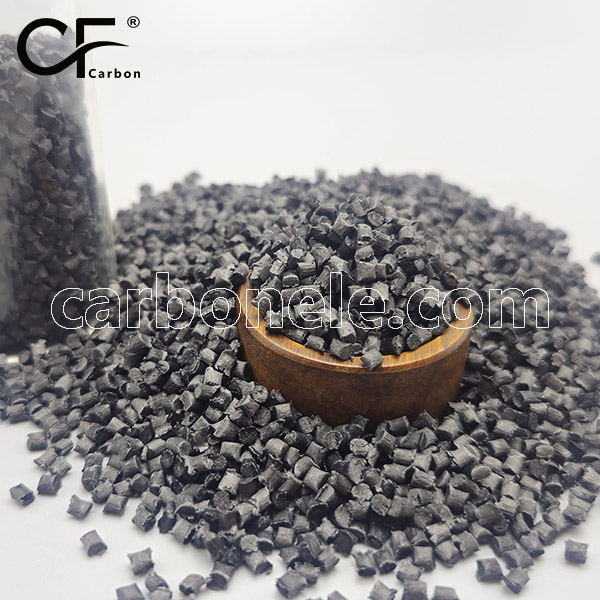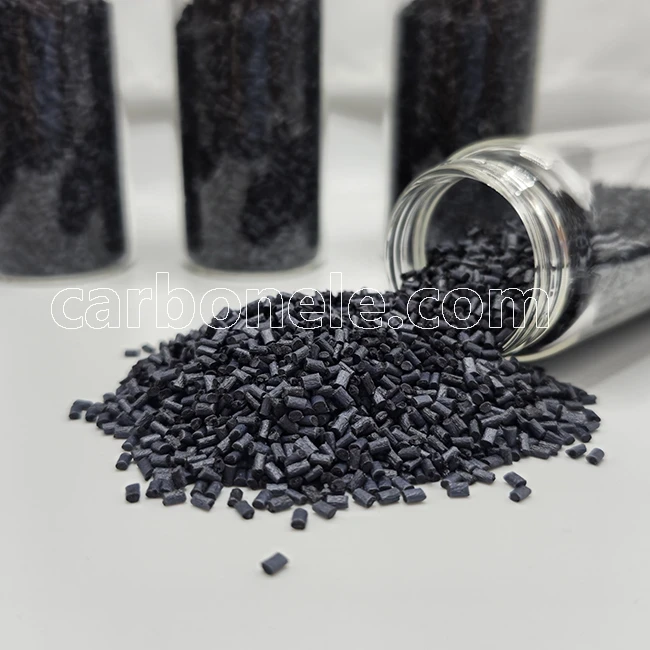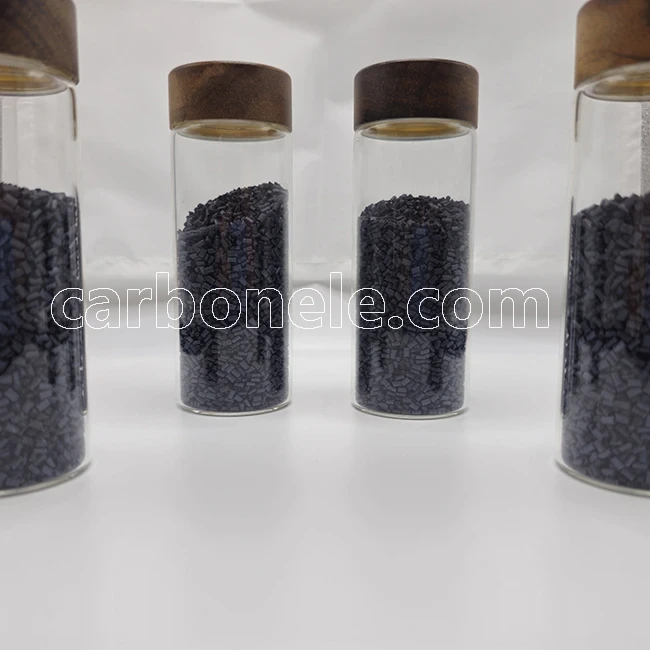
High Quality PBT CF20 for Home Devices – Smart Thermostats
PBT CF20 is a blend of PBT and 20% carbon fiber. It notably boosts mechanical strength, rigidity, and thermal resistance. Widely employed in automotive and aerospace, it offers superior stability and significantly reduces weight, enhancing performance.
- Manufacturer: Carbon New Material
- OEM/ODM: Acceptable
- Color: Black
- Free samples: ≤10kg
- MOQ: 100kg
- Port: Xiamen
- Model No.: PBT-CF-BCA2
A Specific Application of PBT CF20% Compounds
The PBT CF20 material has found an excellent application in the manufacturing of smart home devices. Consider a smart thermostat, for example. The casing of this thermostat is made from PBT CF20% supplied by Carbon (Xiamen) New Material. The material’s combination of strength and durability ensures that the thermostat can withstand the rigors of daily use and potential impacts. Its low moisture absorption property helps maintain the integrity of the casing, preventing any warping or degradation over time, even in environments with fluctuating humidity levels.
The thermal stability of PBT CF 20% provided by Carbon (Xiamen) New Material is crucial in this application. The thermostat is often exposed to temperature variations, but the material ensures that the casing does not deform or lose its mechanical properties. Additionally, the electrical insulation properties of PBT compounds with CF20% filled provide a safe barrier, protecting the internal electronic components from potential electrical faults.
The lightweight nature of PBT 20% CF also contributes to the overall design of the thermostat. It makes installation and handling easier without sacrificing the robustness and functionality of the device. The aesthetic appeal of the material adds to the modern and sleek look of the thermostat, making it not only functional but also visually appealing in the home environment. Overall, PBT CF20 proves to be an ideal choice for this smart home application.
What’s PBT CF20%?
PBT CF20 is a specific type of composite material that plays a significant role in various industrial applications. Let me elaborate on it in detail:
PBT (Polybutylene Terephthalate):
PBT is a type of thermoplastic polymer that stands out for its remarkable durability and stability. Belonging to the polyester family, it finds extensive use across a wide range of applications. Its excellent mechanical properties, such as high tensile and compressive strengths, make it suitable for withstanding mechanical stresses. Moreover, its resistance to a wide variety of chemicals, including acids, bases, and solvents, ensures its integrity in harsh environments. The low moisture absorption characteristic of PBT is another advantage, as it helps maintain the material’s mechanical and electrical properties over time. PBT is commonly utilized in automotive parts like gears, connectors, and housings; electrical components such as switches and sockets; and consumer goods like household appliances and electronic devices.
CF20:
The “CF20” designation typically indicates a specific formulation or grade of PBT that incorporates carbon fiber reinforcement. Carbon fiber, known for its exceptional strength and stiffness, is used to significantly enhance the material’s mechanical properties. In this case, “CF20” likely suggests that the PBT is reinforced with 20% carbon fiber by weight. This reinforcement not only boosts the tensile strength and stiffness of the PBT but also improves its impact resistance and fatigue strength. The uniform distribution of carbon fibers within the PBT matrix provides enhanced mechanical performance across different directions, making the material more reliable in complex loading conditions.
What’re the Application Fields of PBT CF 20?
PBT CF20 is widely adopted in applications where high strength and rigidity are indispensable. The carbon fiber reinforcement offers superior dimensional stability, meaning the material retains its shape and size with minimal variation even when subjected to varying temperatures and mechanical stress. This is crucial in applications where precise tolerances are required, such as in the manufacturing of precision instruments and aerospace components. Common uses include automotive parts such as engine components like pistons, crankshafts, and intake manifolds, where the combination of strength and lightweight properties is essential for improved fuel efficiency and performance. In the aerospace industry, it is employed in structural elements like wing spars, fuselage panels, and landing gear components, where the reduction in weight without sacrificing strength is of paramount importance. Additionally, PBT CF20 is used in high-performance industrial equipment such as machine tools, robotics, and conveyor systems, where it can withstand heavy loads and continuous operation.
Why to Choose It?
1. Enhanced Strength: The carbon fibers increase the tensile strength and stiffness of the PBT by several folds. This enables the material to handle higher loads and stresses without failure, extending the lifespan of the components made from it.
2. Dimensional Stability: The material maintains its shape and dimensions with exceptional accuracy even under extreme temperature fluctuations and mechanical loading. This ensures consistent performance and tight fits in assemblies, reducing the risk of malfunction and improving overall reliability.
3. Reduced Weight: Carbon fiber reinforcement allows for a significant reduction in weight compared to traditional materials like metals, without sacrificing strength. This is particularly crucial in automotive and aerospace applications where weight reduction leads to improved fuel efficiency, increased payload capacity, and enhanced maneuverability.
4. Improved Thermal Resistance: The material exhibits better performance under high-temperature conditions compared to standard PBT. It can withstand elevated temperatures without softening or losing its mechanical properties, making it suitable for applications in engines, exhaust systems, and other heat-intensive environments.
PBT with CF20 filled is a high-performance composite material that combines the inherent advantages of PBT with the enhanced properties conferred by carbon fiber reinforcement. Its unique combination of strength, stiffness, dimensional stability, and reduced weight makes it an ideal choice for demanding industrial applications where performance, reliability, and lightweight design are of utmost importance. However, the higher cost and processing complexities need to be carefully evaluated and balanced against the specific requirements of the application.
If you had any interest in carbon fiber reinforced PBT compounds, please do not hesitate to contact us. Learn more about CFRTPs, please click here or watch relevant videos on YouTube.
Stringent Quality Assurance
Carbon (Xiamen) New Material has put in place a thorough quality examination process throughout the entire sequence, ranging from raw material selection to finished product shipment. In the acquisition of raw materials, highly precise tests are conducted. During manufacturing, every stage is closely supervised and sampled. Non-destructive examinations are utilized to identify defects in the finished goods. This meticulous methodology, along with continuous enhancement endeavors based on quality data analysis, guarantees that each product leaving the factory adheres to or exceeds the most exacting industry norms. A prime example is their zero-defect track record for a specific high-demand product line.

Carbon (Xiamen) New Material
Carbon (Xiamen) New Material Co., Ltd. is an influential enterprise in the field of new materials. The company focuses on researching and developing as well as manufacturing innovative high-performance materials. With advanced technologies and a professional team, it is committed to providing customers with high-quality, environmentally friendly and competitive new material solutions. It has established a good reputation in the market and continuously promotes the development of the industry.

Laboratory Scenario
1. Performance Testing Apparatus Furnished with universal material testing apparatuses, dynamic mechanical analyzers (DMA), thermogravimetric analyzers (TGA), differential scanning calorimeters (DSC), thermal conductivity testers, electrical property testers, etc., to comprehensively assess various attributes of the materials. 2. Microstructure Analysis Devices Comprising scanning electron microscopes (SEM), transmission electron microscopes (TEM), X-ray diffraction analyzers (XRD), etc., for observing and analyzing the microstructure and phase dispersion of the materials.

Frequently Asked Questions
Carbon (Xiamen) New Material Co., Ltd. aims to provide buyers with "one-stop" worry-free high-quality services. Here you can find all information about carbon fiber engineering plastics. If you still have questions, please send us an email for consultation!
-
How can I contact the manufacturer of a product that interests me?
When you find a product you are interested in, you can contact the manufacturer directly by sending an email and we will get back to you as soon as possible.
-
How do I find the products that interest me?
All you need to do is enter the keyword, product name in the search window and press the Enter key on your keyboard. Your search results page will then be displayed. You can also search within the product category pages on the home page. Each category is divided into subcategories, allowing you to refine your search and find products that interest you.
-
Where will I find a buying guide?
Please contact our after-sales service directly and we will provide you with a comprehensive operating guide.
-
What are CF Reinforced Thermoplastic Composites?
CF Reinforced Thermoplastic Composites are materials where carbon fibers are incorporated into a thermoplastic matrix. They combine the strength and stiffness of carbon fibers with the processability and recyclability of thermoplastics. For instance, they are used in automotive parts like bumper beams.
-
What are the benefits of CF Reinforced Thermoplastic Composites over traditional composites?
The key benefits include faster production cycles, easier recyclability, and better impact resistance. They also offer design flexibility. An example is in the manufacturing of consumer electronics casings where complex shapes can be achieved more easily.
-
How are CF Reinforced Thermoplastic Composites processed?
Common processing methods include injection molding, extrusion, and compression molding. Injection molding is widely used for mass production. For example, in the production of small components for the medical industry.
-
What industries use CF Reinforced Thermoplastic Composites?
They are utilized in aerospace, automotive, medical, and sports equipment industries. In aerospace, they can be found in interior components. In the medical field, they might be used in prosthetics.
-
How does the carbon fiber content affect the properties of the composites?
Higher carbon fiber content generally leads to increased strength and stiffness but may reduce ductility. A moderate content is often balanced for specific applications. For example, a higher content might be preferred in structural parts of a race car.
-
What are the challenges in using CF Reinforced Thermoplastic Composites?
Challenges include higher material costs, complex processing equipment requirements, and ensuring uniform fiber dispersion. Issues with adhesion between the fibers and the matrix can also arise. An example is in achieving consistent quality in large-scale production.























